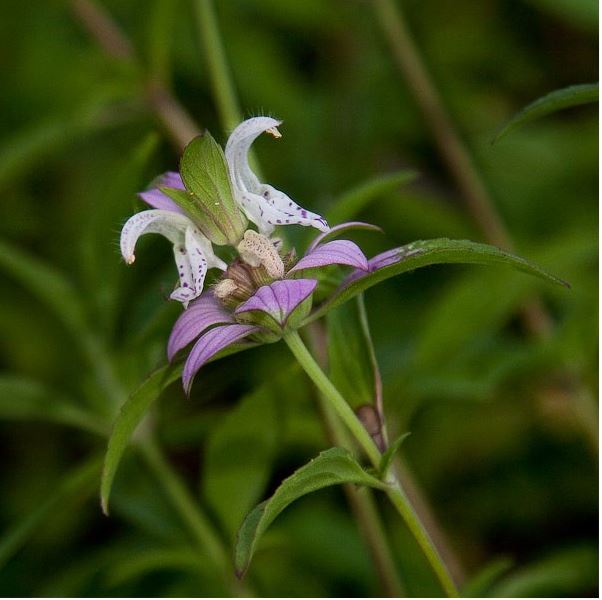Difference between revisions of "Monarda punctata"
| Line 33: | Line 33: | ||
===Phenology=== <!--Timing off flowering, fruiting, seed dispersal, and environmental triggers. Cite PanFlora website if appropriate: http://www.gilnelson.com/PanFlora/ --> | ===Phenology=== <!--Timing off flowering, fruiting, seed dispersal, and environmental triggers. Cite PanFlora website if appropriate: http://www.gilnelson.com/PanFlora/ --> | ||
| − | In the southeastern and mid-Atlantic United States, flowering occurs from July through October.<ref name="Weakley 2015"/> | + | In the southeastern and mid-Atlantic United States, flowering occurs from July through October.<ref name="Weakley 2015"/> On the Florida panhandle, flowering occurs in September and October.<ref name="PanFlora">Nelson G (29 January 2018) PanFlora. Retrieved from gilnelson.com/PanFlora/</ref> |
<!--===Seed dispersal===--> | <!--===Seed dispersal===--> | ||
<!--===Seed bank and germination===--> | <!--===Seed bank and germination===--> | ||
Revision as of 20:51, 29 January 2018
| Monarda punctata | |
|---|---|

| |
| Photo by John B | |
| Scientific classification | |
| Kingdom: | Plantae |
| Division: | Magnoliophyta - Flowering plants |
| Class: | Magnoliopsida - Dicots |
| Order: | Lamiales |
| Family: | Lamiaceae |
| Genus: | Monarda |
| Species: | M. punctata |
| Binomial name | |
| Monarda punctata L. | |

| |
| Natural range of Monarda punctata from USDA NRCS Plants Database. | |
Common Names: Arkansas horse mint; eastern horse-mint; hairy-stem horse mint;[1] spotted beebalm[2]
Contents
Taxonomic Notes
Varieties: M. punctata var. arkansana; M. punctata var. punctata; M. punctata var. villicaulis[1][2] M. punctata var. correllii; M. punctata var. coryi; M. punctata var. intermedia; M. punctata var. lasiodonta; M. punctata var. occidentalis[2]
Description
Monarda punctata is a dioecious species, classified as an annual, biennial, and perennial. It grows as a forb/herb or subshrub.[2] It is an aromatic species that reaches heights of 1-3 ft (0.30-0.91 m). Inflorescence are tubular and yellowish/purple spotted, occurring in whorls that form a dense elongated spike at the end of the stem or leaf axil. It also has bracts that can be purple, pink, white, or yellow.[3]
Distribution
This species is found from New Mexico and Kansas, eastward to Florida, northward to Vermont and Massachusetts, and inland to Iowa and Minnesota. Exceptions to this are Delaware and West Virginia, where no mounted specimens have been reported to the USDA. It also occurs in the Canadian provinces of Ontario and Quebec and has a disjunct population in California.[2]
Ecology
Habitat
M. punctata occurs in dryish forests over mafic rock, maritime forests, dunes, roadsides, rocky or sandy woodlands, and disturbed areas.[1]
Phenology
In the southeastern and mid-Atlantic United States, flowering occurs from July through October.[1] On the Florida panhandle, flowering occurs in September and October.[4]
Pollination
This species is insect pollinated and is of special value to native bees, bumble bees, honey bees, butterflies, and predatory and parasitoid insects that prey upon other insects.[3]
Use by animals
M. punctata composes 5-10% of the diets of large mammals.[5]
Conservation and Management
Cultivation and restoration
Photo Gallery
References and notes
- ↑ 1.0 1.1 1.2 1.3 Weakley AS (2015) Flora of the Southern and Mid-Atlantic States. Chapel Hill, NC: University of North Carolina Herbarium.
- ↑ 2.0 2.1 2.2 2.3 2.4 USDA NRCS (2016) The PLANTS Database (http://plants.usda.gov, 29 January 2018). National Plant Data Team, Greensboro, NC 27401-4901 USA.
- ↑ 3.0 3.1 Plant database: Monarda punctata. (29 January 2018) Lady Bird Johnson Wildflower Center. URL: https://www.wildflower.org/plants/result.php?id_plant=MOPU
- ↑ Nelson G (29 January 2018) PanFlora. Retrieved from gilnelson.com/PanFlora/
- ↑ Miller JH, Miller KV (1999) Forest plants of the southeast and their wildlife uses. Southern Weed Science Society.